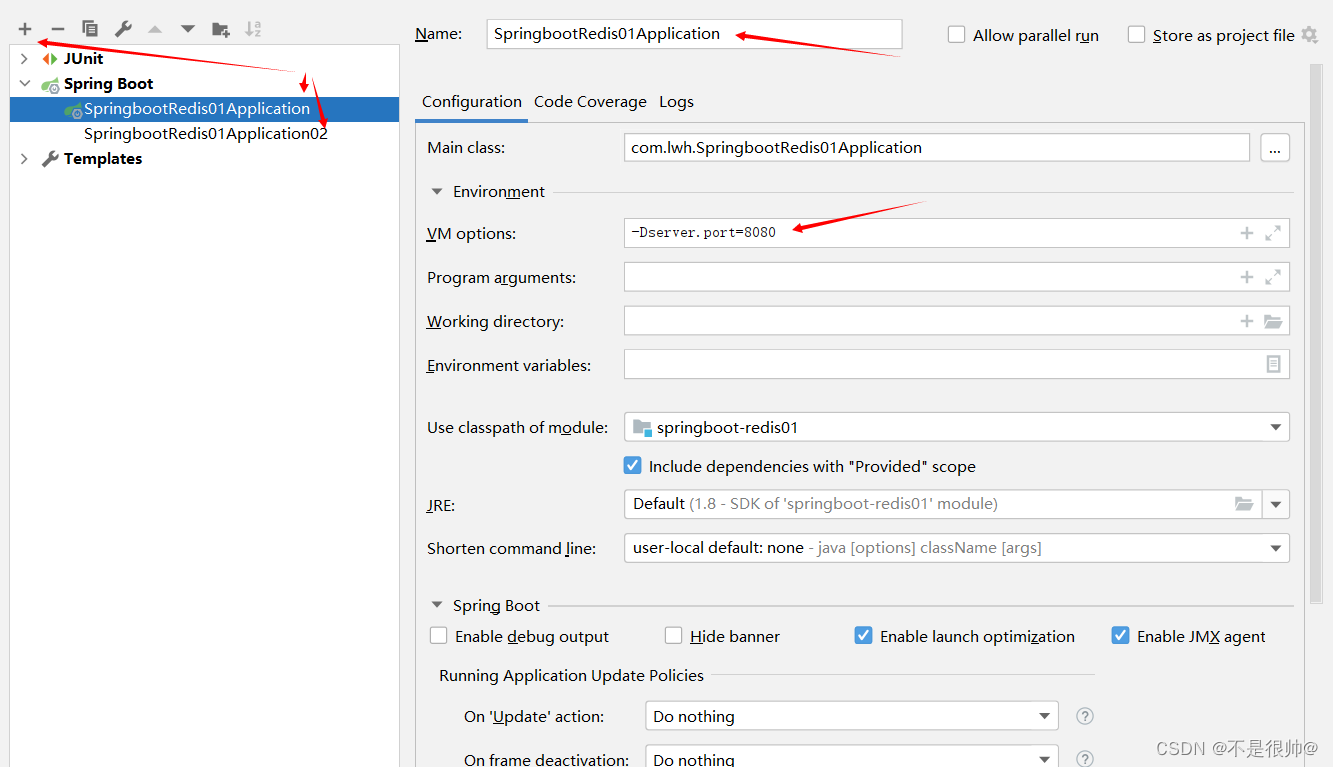1. 大纲
1. springboot整合redis。
2. redis使用场景
3. redis的常见面试题。
2. springboot整合redis。
Jedis集成了Redis的相关命令操作,它是Java语言操作Redis数据库的桥梁。Jedis客户端封装了Redis数据库的大量命令,因此具有许多Redis操作API。可以阅读《Jedis API 文档》。
Jedis 是 Redis 官方推荐的面向 Java 的操作 Redis 的客户端,而 RedisTemplate 是
SpringDataRedis 中对 JedisApi 的高度封装。
springboot整合redis时提供了两个模板工具类,StringRedisTemplate和RedisTemplate.
StringRedisTemplate 继承与 RedisTemplate,两者的数据是不相通的。StringRedisTemplate 只能管理 StringRedisTemplate 中的数据。
RedisTemplate 只能管理RedisTemplate 中的数据。
StringRedisTemplate 默认采用的是 string 的序列化策略,
RedisTemplate 默认采用的是 JDK 的序列化策略。必须指定序列化方式
StringRedisTemplate
(1) 引入相关的依赖
<dependency>
<groupId>org.springframework.boot</groupId>
<artifactId>spring-boot-starter-data-redis</artifactId>
</dependency>
(2)注入StringRedisTemplate该类对象
@Autowired
private StringRedisTemplate redisTemplate;
(3)使用StringRedisTemplate
该类把对每种数据类型的操作,单独封了相应的内部类。
package com.ykq.qy151redisspringboot;
import org.junit.jupiter.api.Test;
import org.springframework.beans.factory.annotation.Autowired;
import org.springframework.boot.test.context.SpringBootTest;
import org.springframework.data.redis.core.HashOperations;
import org.springframework.data.redis.core.StringRedisTemplate;
import org.springframework.data.redis.core.ValueOperations;
import java.util.HashMap;
import java.util.List;
import java.util.Map;
import java.util.Set;
import java.util.concurrent.TimeUnit;
@SpringBootTest
class Qy151RedisSpringbootApplicationTests {
//里面所有的key还是value field它的类型必须都是String类型。
//因为key和value获取field他们使用的都是String的序列化方式
@Autowired
private StringRedisTemplate redisTemplate;
@Test
public void test02(){
//对hash类型的操作。
HashOperations<String, Object, Object> forHash = redisTemplate.opsForHash();
forHash.put("k1","name","张三");
forHash.put("k1","age","15");
Map<String,String> map=new HashMap<>();
map.put("name","李四");
map.put("age","25");
forHash.putAll("k2",map);
Object o = forHash.get("k1", "name");
System.out.println(o);
Set<Object> k1 = forHash.keys("k1");
System.out.println(k1);
List<Object> k11 = forHash.values("k1");
System.out.println(k11);
//获取k1对于的所有的field和value
Map<Object, Object> k12 = forHash.entries("k1");
System.out.println(k12);
}
@Test
void contextLoads() {
//删除指定的key
// redisTemplate.delete();
//查看所有的key
// redisTemplate.keys()
//是否存在指定的key
// redisTemplate.hasKey()
//对字符串数据类型的操作ValueOperations
ValueOperations<String, String> forValue = redisTemplate.opsForValue();
//存储字符串类型--key value long unit setex();
forValue.set("k1","张三",30, TimeUnit.SECONDS);
//等价于setnx 存入成功返回true,失败返回false
Boolean absent = forValue.setIfAbsent("k11", "李四", 30, TimeUnit.SECONDS);
System.out.println(absent);
Integer append = forValue.append("k11", "真帅");
String key = forValue.get("k11");
}
}
RedisTemplate
package com.ykq.qy151redisspringboot;
import org.junit.jupiter.api.Test;
import org.springframework.beans.factory.annotation.Autowired;
import org.springframework.boot.test.context.SpringBootTest;
import org.springframework.data.redis.core.HashOperations;
import org.springframework.data.redis.core.RedisTemplate;
import org.springframework.data.redis.core.StringRedisTemplate;
import org.springframework.data.redis.core.ValueOperations;
import org.springframework.data.redis.serializer.GenericJackson2JsonRedisSerializer;
import org.springframework.data.redis.serializer.Jackson2JsonRedisSerializer;
import org.springframework.data.redis.serializer.StringRedisSerializer;
import java.util.HashMap;
import java.util.List;
import java.util.Map;
import java.util.Set;
import java.util.concurrent.TimeUnit;
@SpringBootTest
class Qy151RedisSpringbootApplicationTests02 {
//当你存储的value类型为对象类型使用redisTemplate
//存储的value类型为字符串。StringRedisTemplate 验证码
@Autowired
private RedisTemplate redisTemplate;
@Test
public void test01(){
//必须认为指定序列化方式
redisTemplate.setKeySerializer(new StringRedisSerializer());
redisTemplate.setValueSerializer(new Jackson2JsonRedisSerializer<Object>(Object.class));
//对String类型操作类
ValueOperations forValue = redisTemplate.opsForValue();
//redis中key和value都变成乱码了。
//key和value都没有指定序列化方式,默认采用jdk的序列化方式。
forValue.set("k1","张三");
//value默认采用jdk,类必须实现序列化接口
forValue.set("k2",new User(1,"刘德华",22));
}
}
上面的RedisTemplate需要每次都指定key value以及field的序列化方式,能不能搞一个配置类,已经为RedisTemplate指定好序列化。以后再用就无需指定。
package com.ykq.qy151redisspringboot.config;
import com.fasterxml.jackson.annotation.JsonAutoDetect;
import com.fasterxml.jackson.annotation.PropertyAccessor;
import com.fasterxml.jackson.databind.ObjectMapper;
import org.springframework.context.annotation.Bean;
import org.springframework.context.annotation.Configuration;
import org.springframework.data.redis.connection.RedisConnectionFactory;
import org.springframework.data.redis.core.RedisTemplate;
import org.springframework.data.redis.serializer.Jackson2JsonRedisSerializer;
import org.springframework.data.redis.serializer.RedisSerializer;
import org.springframework.data.redis.serializer.StringRedisSerializer;
@Configuration
public class RedisConfig {
@Bean
public RedisTemplate<String, Object> redisTemplate(RedisConnectionFactory factory) {
RedisTemplate<String, Object> template = new RedisTemplate<>();
RedisSerializer<String> redisSerializer = new StringRedisSerializer();
Jackson2JsonRedisSerializer jackson2JsonRedisSerializer = new Jackson2JsonRedisSerializer(Object.class);
ObjectMapper om = new ObjectMapper();
om.setVisibility(PropertyAccessor.ALL, JsonAutoDetect.Visibility.ANY);
om.enableDefaultTyping(ObjectMapper.DefaultTyping.NON_FINAL);
jackson2JsonRedisSerializer.setObjectMapper(om);
template.setConnectionFactory(factory);
//key序列化方式
template.setKeySerializer(redisSerializer);
//value序列化
template.setValueSerializer(jackson2JsonRedisSerializer);
//value hashmap序列化 filed value
template.setHashValueSerializer(jackson2JsonRedisSerializer);
template.setHashKeySerializer(redisSerializer);
return template;
}
}
3. redis的使用场景
3.1 作为缓存
(1)数据存储在内存中,数据查询速度快。可以分摊数据库压力。
![[外链图片转存失败,源站可能有防盗链机制,建议将图片保存下来直接上传(img-Rn8Zrthi-1659491913258)(assets/1659426481991.png)]](https://img-blog.csdnimg.cn/3ec71de5ec8546259419311edd0ca007.png)
(2)什么样的数据适合放入缓存
查询频率比较高,修改频率比较低。
安全系数低的数据
(3)使用redis作为缓存
package com.ykq.qy151redisspringboot.service;
import com.ykq.qy151redisspringboot.dao.DeptMapper;
import com.ykq.qy151redisspringboot.entity.Dept;
import org.springframework.beans.factory.annotation.Autowired;
import org.springframework.data.redis.core.RedisTemplate;
import org.springframework.data.redis.core.ValueOperations;
import org.springframework.stereotype.Service;
import org.springframework.transaction.annotation.Transactional;
import java.util.concurrent.TimeUnit;
@Service
public class DeptService {
@Autowired
private DeptMapper deptMapper;
@Autowired
private RedisTemplate redisTemplate;
//业务代码
public Dept findById(Integer id){
ValueOperations forValue = redisTemplate.opsForValue();
//查询缓存
Object o = forValue.get("dept::" + id);
//缓存命中
if(o!=null){
return (Dept) o;
}
Dept dept = deptMapper.selectById(id);
if(dept!=null){
//存入缓存中
forValue.set("dept::"+id,dept,2, TimeUnit.HOURS);
}
return dept;
}
public int deleteById(Integer id){
redisTemplate.delete("dept::"+id);
int row = deptMapper.deleteById(id);
return row;
}
public Dept insert(Dept dept){
int insert = deptMapper.insert(dept);
return dept;
}
public Dept update(Dept dept){
ValueOperations forValue = redisTemplate.opsForValue();
forValue.set("dept::"+dept.getId(),dept,2, TimeUnit.HOURS);
int insert = deptMapper.updateById(dept);
return dept;
}
}
查看的缓存: 前部分代码相同@before通知,后部分代码也相同后置通知。 我们可以AOP完成缓存代码和业务代码分离。
spring框架它应该也能想到。–使用注解即可完成。解析该注解。
(1)把缓存的配置类加入
@Bean
public CacheManager cacheManager(RedisConnectionFactory factory) {
RedisSerializer<String> redisSerializer = new StringRedisSerializer();
Jackson2JsonRedisSerializer jackson2JsonRedisSerializer = new Jackson2JsonRedisSerializer(Object.class);
//解决查询缓存转换异常的问题
ObjectMapper om = new ObjectMapper();
om.setVisibility(PropertyAccessor.ALL, JsonAutoDetect.Visibility.ANY);
om.enableDefaultTyping(ObjectMapper.DefaultTyping.NON_FINAL);
jackson2JsonRedisSerializer.setObjectMapper(om);
// 配置序列化(解决乱码的问题),过期时间600秒
RedisCacheConfiguration config = RedisCacheConfiguration.defaultCacheConfig()
.entryTtl(Duration.ofSeconds(600)) //缓存过期10分钟 ---- 业务需求。
.serializeKeysWith(RedisSerializationContext.SerializationPair.fromSerializer(redisSerializer))//设置key的序列化方式
.serializeValuesWith(RedisSerializationContext.SerializationPair.fromSerializer(jackson2JsonRedisSerializer)) //设置value的序列化
.disableCachingNullValues();
RedisCacheManager cacheManager = RedisCacheManager.builder(factory)
.cacheDefaults(config)
.build();
return cacheManager;
}
(2)使用开启缓存注解

(3)使用注解
//使用查询注解:cacheNames表示缓存的名称 key:唯一标志---dept::key
//先从缓存中查看key为(cacheNames::key)是否存在,如果存在则不会执行方法体,如果不存在则执行方法体并把方法的返回值存入缓存中
@Cacheable(cacheNames = {"dept"},key="#id")
public Dept findById(Integer id){
Dept dept = deptMapper.selectById(id);
return dept;
} //先删除缓存在执行方法体。
@CacheEvict(cacheNames = {"dept"},key = "#id")
public int deleteById(Integer id){
int row = deptMapper.deleteById(id);
return row;
}
//这个注释可以确保方法被执行,同时方法的返回值也被记录到缓存中,实现缓存与数据库的同步更新。
@CachePut(cacheNames = "dept",key="#dept.id")
public Dept update(Dept dept){
int insert = deptMapper.updateById(dept);
return dept;
}
3.2 分布式锁
使用压测工具测试高并发下带来线程安全问题
![[外链图片转存失败,源站可能有防盗链机制,建议将图片保存下来直接上传(img-FVld06wF-1659491913259)(assets/1659431394965.png)]](https://img-blog.csdnimg.cn/defd1a7fb7e14ce6bd354b28d2e295ec.png)
我们看到同一个库存被使用了n次。以及数据库中库存为负数。 线程安全问题导致。
1. 解决方案: 使用 synchronized 或者lock锁
package com.ykq.distrinctlock.service.impl;
import com.ykq.distrinctlock.dao.ProductStockDao;
import com.ykq.distrinctlock.service.ProductStockService;
import org.springframework.beans.factory.annotation.Autowired;
import org.springframework.stereotype.Service;
@Service
public class ProductStockServiceImpl2 implements ProductStockService {
@Autowired
private ProductStockDao productStockDao;
@Override
public String decreaseStock(Integer productId) {
synchronized (this) {
//查看该商品的库存数量
Integer stock = productStockDao.findStockByProductId(productId);
if (stock > 0) {
//修改库存每次-1
productStockDao.updateStockByProductId(productId);
System.out.println("扣减成功!剩余库存数:" + (stock - 1));
return "success";
} else {
System.out.println("扣减失败!库存不足!");
return "fail";
}
}
}
}
使用synchronized 或者lock锁只适用与单机场景, 如果我们搭建了项目集群,那么该锁无效。
![[外链图片转存失败,源站可能有防盗链机制,建议将图片保存下来直接上传(img-2Fc7GWK8-1659491913260)(assets/1659431926323.png)]](https://img-blog.csdnimg.cn/c75dc841324f4b00b95f605f6968d7f2.png)
使用idea开集群项目

![[外链图片转存失败,源站可能有防盗链机制,建议将图片保存下来直接上传(img-LzMKC5ZL-1659491913260)(assets/1659432104530.png)]](https://img-blog.csdnimg.cn/1cb0162b02cf4ecc995c39620f6cccfd.png)
发现又出现: 重复数字以及库存为负数。
解决办法是用redis的分布式锁
![[外链图片转存失败,源站可能有防盗链机制,建议将图片保存下来直接上传(img-1ZNZqdNL-1659491913260)(assets/1659433857619.png)]](https://img-blog.csdnimg.cn/76da9d44bf08406cb74156ab846538ad.png)
3.2.1 分布式锁测试(springboot-redis01)
分布式锁的特点
首先,为了确保分布式锁可用,我们至少要确保锁的实现同时满足以下四个条件:1、互斥性:任意时刻,只能有一个客户端获取锁,不能同时有两个客户端获取到锁。
2、安全性:锁只能被持有该锁的客户端删除,不能由其它客户端删除。
3、死锁:获取锁的客户端因为某些原因(如down机等)而未能释放锁,其它客户端再也无法获取到该锁。
4、容错:当部分节点(redis节点等)down机时,客户端仍然能够获取锁和释放锁。
1、引入mybatisplus的依赖(简化开发)
<dependency>
<groupId>com.baomidou</groupId>
<artifactId>mybatis-plus-boot-starter</artifactId>
<version>3.4.2</version>
</dependency>
<?xml version="1.0" encoding="UTF-8"?>
<!DOCTYPE mapper PUBLIC "-//mybatis.org//DTD Mapper 3.0//EN" "http://mybatis.org/dtd/mybatis-3-mapper.dtd">
<mapper namespace="com.lwh.mapper.StockMapper">
<update id="updateStockByProductId">
update stock set count =count -1 where id=#{productId}
</update>
</mapper>
对应的mapper
@Mapper
public interface StockMapper extends BaseMapper<Stock> {
int updateStockByProductId(int productId);
}
业务代码及测试
package com.lwh.controller;
import com.lwh.entity.Stock;
import com.lwh.mapper.StockMapper;
import org.springframework.beans.factory.annotation.Autowired;
import org.springframework.data.redis.core.RedisTemplate;
import org.springframework.data.redis.core.StringRedisTemplate;
import org.springframework.data.redis.core.ValueOperations;
import org.springframework.web.bind.annotation.GetMapping;
import org.springframework.web.bind.annotation.PathVariable;
import org.springframework.web.bind.annotation.RestController;
@RestController
public class StockController {
@Autowired
private StockMapper mapper;
@Autowired
private StringRedisTemplate redisTemplate;
@GetMapping("demoNginx/{productId}")
public String decreaseStock(@PathVariable int productId) {
ValueOperations ops = redisTemplate.opsForValue();
Boolean flag = ops.setIfAbsent("lwh::" + productId, "```");
if (flag) {
try {
//查看该商品的库存数量
Stock stock = mapper.selectById(productId);
int count = stock.getCount();
if (count > 0) {
//修改库存每次-1
mapper.updateStockByProductId(productId);
System.out.println("扣减成功!剩余库存数:" + (count - 1));
return "success";
} else {
System.out.println("扣减失败!库存不足!");
return "fail";
}
} finally {
redisTemplate.delete("lwh::" + productId);
}
}
return "服务器正忙,请稍后在试......";
}
}
开启nginx服务,开启jmeter测试
数据库中的数据不会出现异常






















 1015
1015











 被折叠的 条评论
为什么被折叠?
被折叠的 条评论
为什么被折叠?








